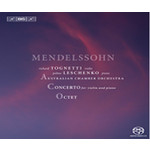
Mendelssohn - Double Concerto & Octet
 $35.00
Out of Stock
$35.00
Out of Stock6+ weeks add to cart
FELIX MENDELSSOHN
Mendelssohn - Double Concerto & Octet
Polina Leschenko (piano) Richard Tognetti (violin) / Australian Chamber Orchestra
[ BIS SACD / Hybrid SACD ]
Release Date: Friday 1 February 2013
This item is currently out of stock. It may take 6 or more weeks to obtain from when you place your order as this is a specialist product.
Among the many child prodigies that have made their mark in the history of music, Felix Mendelssohn is, along with Mozart, possibly the most impressive. By the age of fifteen he had already composed 13 string symphonies and a number of concertos, and his first 'proper' symphony was not far away. He wasn't just highly productive, however - his contemporaries already recognized the high quality of the works he produced: 'Felix Mendelssohn composes with the greatest conceivable ease and with inextinguishable abundance of spirit, the most difficult pieces…' wrote a German reviewer in 1822. Both pieces recorded here were composed with Mendelssohn's friend and violin teacher, Eduard Ritz, in mind. Felix himself premièred the Double Concerto in D minor with Ritz in May 1823 at one of the famous Sunday concerts at the Mendelssohn residence in Berlin, but except for a second outing later the same year, the work remained unperformed until 1957. Here the piano part - in turn quick-silvery and lyrical - is defended by the Russian-born pianist Polina Leschenko, making her first appearance on BIS. She is partnered by Richard Tognetti, artistic director and leader of the Australian Chamber Orchestra. Tognetti also leads seven of his colleagues from the ACO in the String Octet in E flat major, which Mendelssohn composed as a birthday present for Eduard Ritz. Written two years after the concerto, the octetonly received its first public performance in 1836 but quickly became immensely popular. Although it belongs to the genre of chamber music, Mendelssohn himself underlined that it was to be played by all the instruments 'in symphonic orchestral style'. He also explored the orchestral potential of the work at a performance of his Symphony No.1 in 1829, replacing the symphony's minuet with an expanded arrangement of the Octet's scherzo.
Tracks:
Concerto in D minor for Violin, Piano and Strings (1823); Octet in E flat major, Op.20